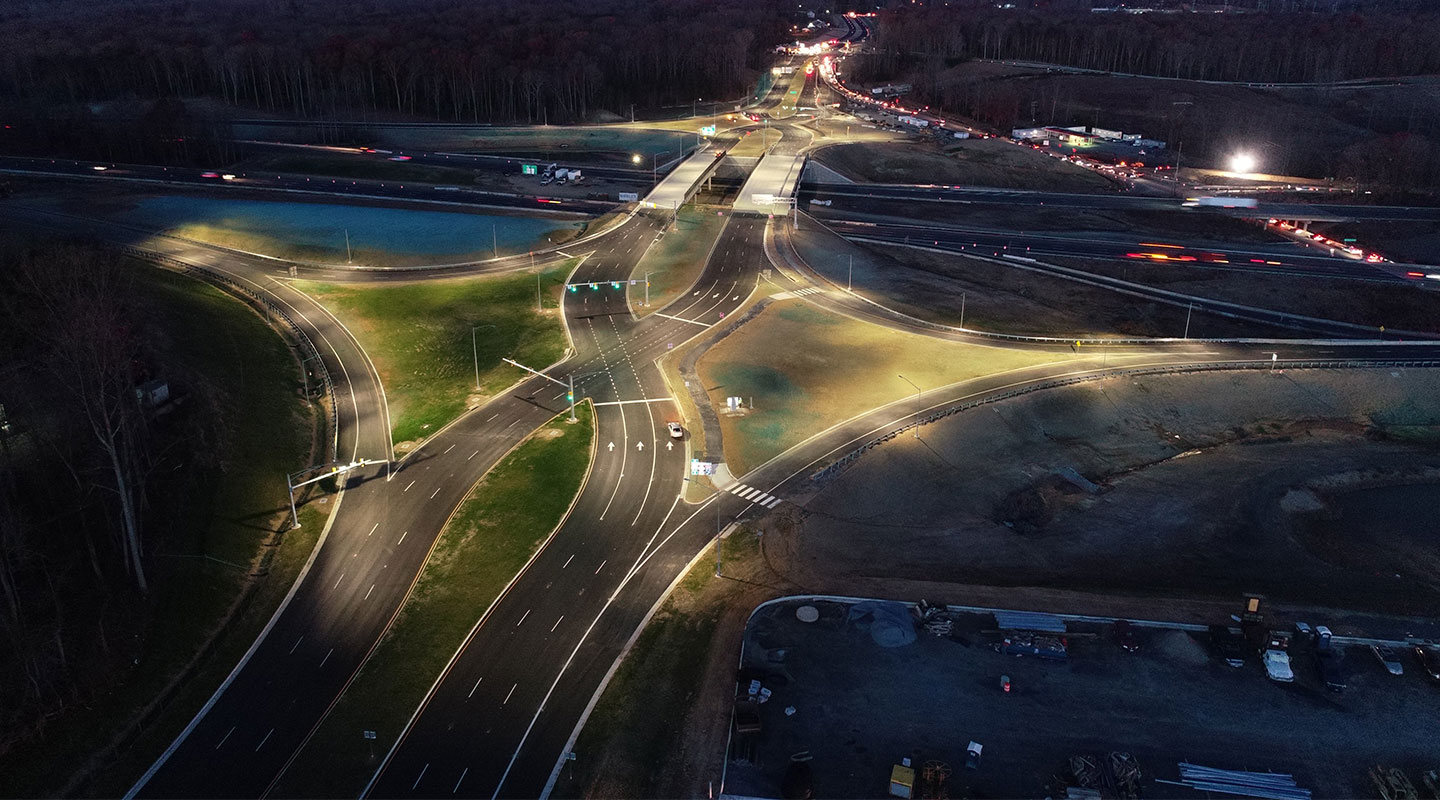Transportation engineers have several interchange configurations in their toolbox that can be selected to create a commuter experience that is both safe and relieves traffic. This list of interchange configurations includes full cloverleaf, directional
or semi-directional flyovers, partial interchanges, single point urban interchanges, diamonds, and now diverging diamonds – all of which can be considered to best fit the project’s goals and traffic conditions and volumes. For the I-95
at Route 630 (Courthouse Road) Interchange project located in Stafford County, Virginia, the Virginia Department of Transportation (VDOT) opted for the relatively new configured diverging diamond interchange to best fit the needs of commuters and
the surrounding communities.
What is a Diverging Diamond Interchange?
A diverging diamond interchange temporarily crosses traffic to the opposite side of the road. Instead of driving on the right side of the road like we're used to, one crosses over via signalized intersections and travels on the left side of the road temporarily
as you go through the interchange. This allows the left turn movements to be made unrestricted and unopposed.
What are the Benefits?
- Reduces the number of conflict points found at a conventional diamond interchange
- Helps with intersections where through volumes are low but turning volumes are high where commuters who need to make a left turn have difficulty finding gaps in traffic
- With less funding – a couple million dollars instead of tens of millions of dollars – transportation professionals can modify an existing interchange by constructing the crossovers, shifting traffic to the opposite side, and then reusing
the bridges and interchange ramps, thereby extending the operational life of the interchange

This drone aerial shot shows the crossover points to the left side of traffic. This photo was not taken over live traffic.
Origins of the I-95 at VA 630 Diverging Diamond Interchange
For the I-95 at Route 630 project, the decision was made by VDOT to go with a diverging diamond interchange before our team was involved. The decision wasn't to extend the service life of the interchange, but rather because it required less right-of-way
and would be less impactful than some of the other configurations that were under consideration. This configuration would handle the traffic projections acceptably and would reduce the footprint of the project. Our team was tasked with completely
replacing the existing diamond interchange by realigning Route 630 approximately 800 feet to the south and configuring the new interchange with an overpass of I-95 instead of going under as the existing interchange did.
Project Success through Community Engagement
Due to lessons learned from previous diverging diamond projects, we worked with VDOT on an extensive public outreach campaign to overcome the challenge of residents and commuters not understanding how one might work. In previous areas where a it was implemented,
communities expressed concerns about driving down the “wrong” side of the road, turning incorrectly, or accidently not paying attention to the signage.
Our extensive communications effort in collaboration with VDOT included a variety of educational media and exhibits. Our team worked on animations, fly-throughs, renderings, and put up
physical exhibits throughout the surrounding communities. VDOT incorporated training for the interchange into the driver’s education at a nearby high school. We also worked with a subconsultant on two movie trailers that were showcased at local
movie theaters in Fredericksburg, Virginia, over the winter of 2019, prior to the interchange opening, so that people could familiarize themselves with the interchange operations.
We conducted several public information meetings for the communities along the corridor to both share the impacts associated with the highway widening and the functions of the new interchange. One unique exhibit that we set up for the project at the
local high school was a large 50-foot directional mat on the floor that visitors could walk along and pretend that they were in a car to mimic the motions of the diverging diamond interchange. The exhibit included graphics of all the highway signs so
that visitors could see what the updated signage would look like, where the traffic signals would be, and how it would operate.
Why the Project is One I Won’t Soon Forget
From the size of the project to the large number of variables in the design and construction of the interchange, the project is one that I won’t soon forget. The project encompassed two and a half miles of roadway widening and reconstruction and
included a more than 1,000-space park and ride lot with bus shelters, motorcycle spaces, slug line accommodations, bus drop-offs, and pick-up accommodations. The surrounding communities are starting to grow rapidly. Driving down the corridor today,
it fascinates me to think of what the corridor looked like just a few years ago.
Ultimately, a diverging diamond interchange configuration is not a “silver bullet” that should be used everywhere, but if designed and constructed in the right circumstances, it can be successful in relieving congestion and improving driver
safety.